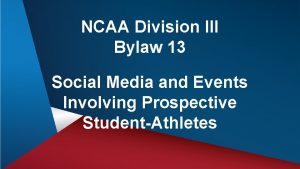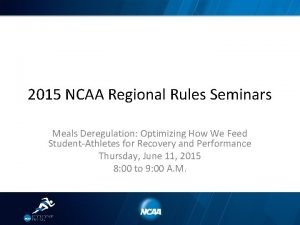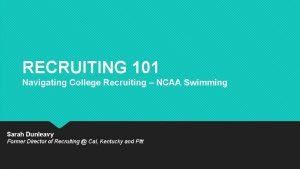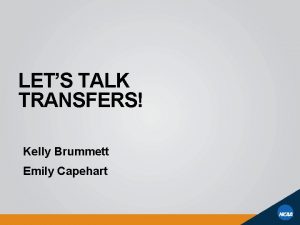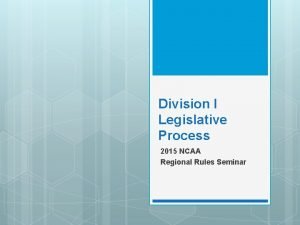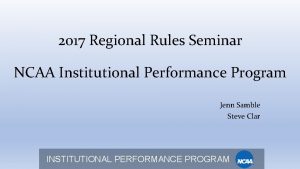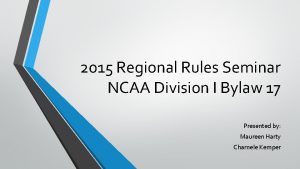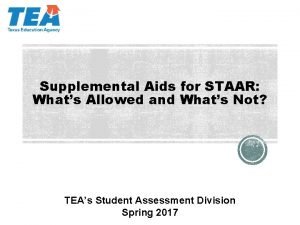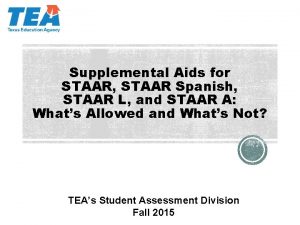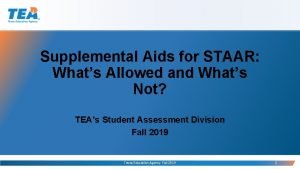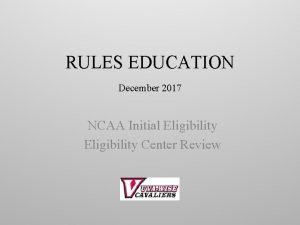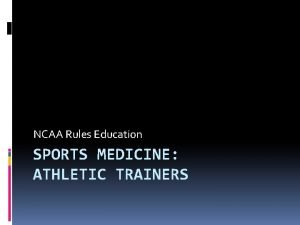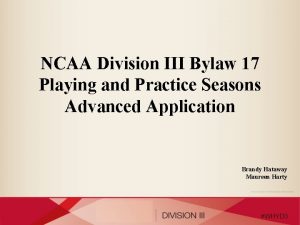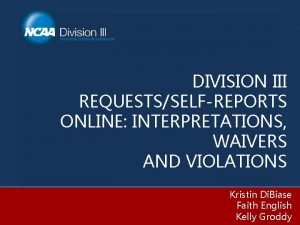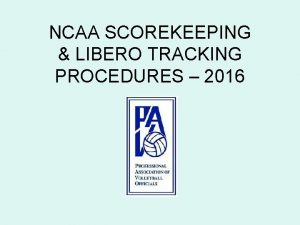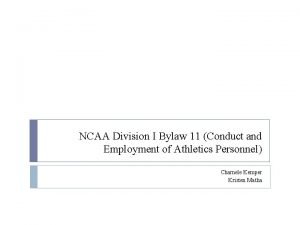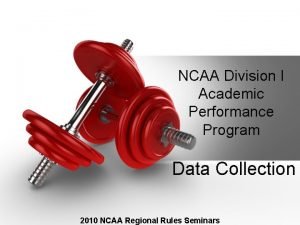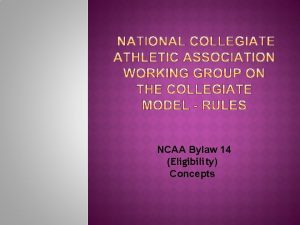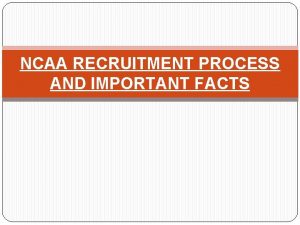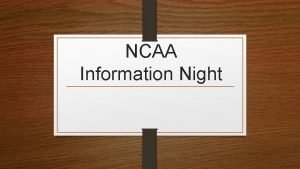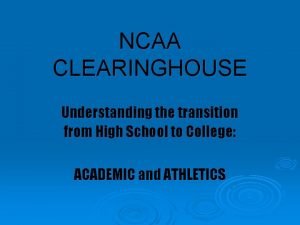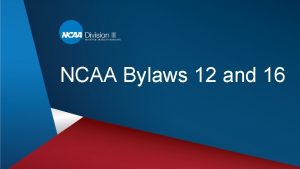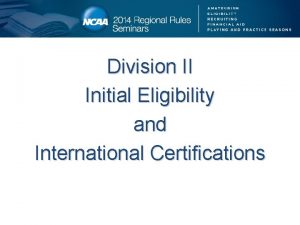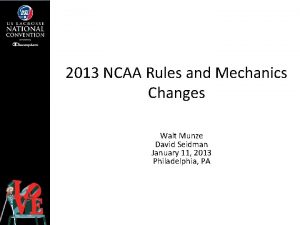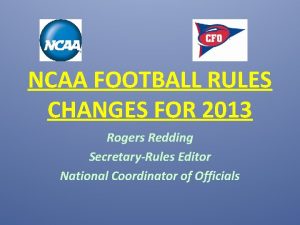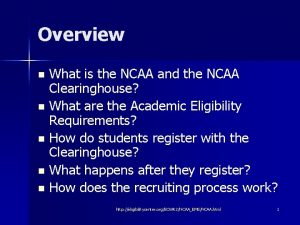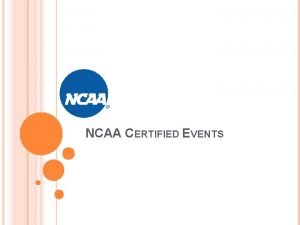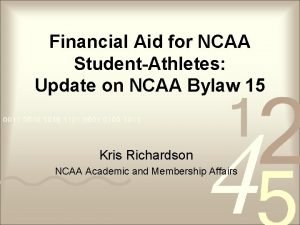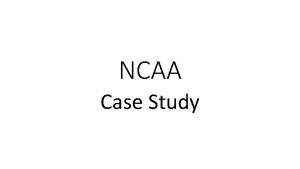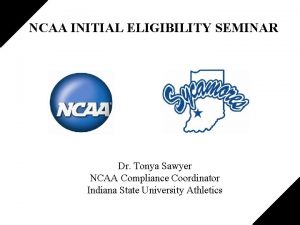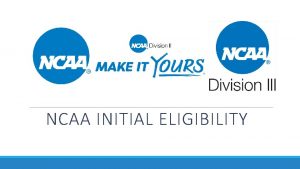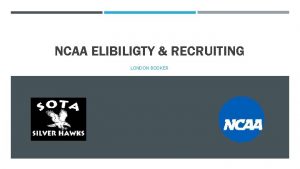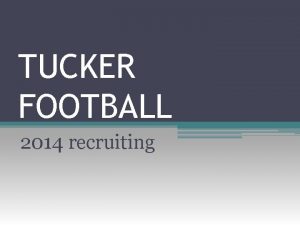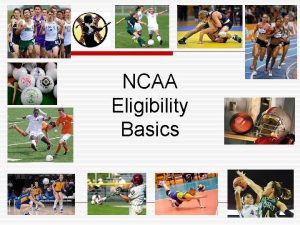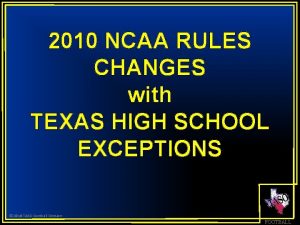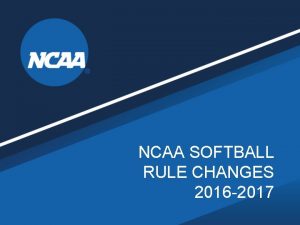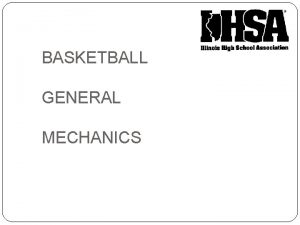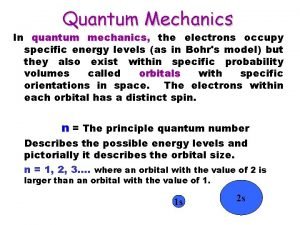2013 NCAA Rules and Mechanics Changes Walt Munze


































- Slides: 34

2013 NCAA Rules and Mechanics Changes Walt Munze David Seidman January 11, 2013 Philadelphia, PA Updated 1/22/13

POINTS OF EMPHASIS • Faceoff player touching his own or his opponent’s crosse with any part of his body • Illegal Tactics When Defending (e. g. , Cross-check/hold) – thrusting the crosse, in particular • Sideline Behavior

RULE 1 -10 & FIELD DIAGRAM TABLE AREA, TEAM BENCHES • Substitution box expanded to be 20 yards. – Dimensions of the Coaches, Team and Bench Areas remain the same.

RULE 1 -16 EQUIPMENT THE BALL • A minimum of six balls must be available at each end line and sideline. The number of balls in each area is to be equal. On the bench side, balls should be placed at the scorer’s table and outside each bench area. These balls shall be replenished by the home team and game management staff. This will assist with the pace of play and faster restarts. – RULING: Repeated delays could result in technical foul delay-of-game violations against the home team.

RULE 1 -17 – 19 Stick specifications • Any strings or laces (e. g. , shooting strings) must be will be located within 4 inches from the top of the crosse in an arc. Also, no more than one sidewall string on each side of the crosse will be allowed. • “Donuts” are prohibited.

Added Stick Check Field Tests • The ball is placed in the crosse (horizontal to the ground) at the deepest point of the pocket, then the crosse is tipped forward (head down) 90 degrees so the ball rolls out at the tip of the head; • The ball is placed in the back of the crosse at the deepest point of the pocket and pushed in to reverse the pocket. The crosse is inverted 180 degrees. The ball must come out of the crosse without shaking, etc. – NOTE: Three-minute non-releasable foul if the stick fails any of these tests – A crosse found illegal due to a deep pocket will carry a oneminute nonreleasable penalty and the crosse may be returned if adjusted.

Stick Check Procedures

RULE 1 -9 & 4 -3 TAPE ON THE FACE-OFF STICKS • Tape of a color contrasting with the color of the head must be placed on the handle just below the throat of the crosse of any player taking a faceoff. No tape is allowed on the plastic. A tape violation is enforced as a pre-whistle violation. • As a point of emphasis officials are to enforce the rule that says players must keep their hands off of the plastic of the crosse. Players can gain an unfair advantage to gain possession of the ball if this is not called.

RULE 4 -3: Faceoffs • After two pre or post-whistle violations in one half by a team, subsequent violations result in a 30 -second technical penalty (served by in-home). • Violations by the wing players before or during the faceoff will count toward the three per half. • Faceoff player is no longer required to leave the field on a violation. – “Post Whistle” pertains to faceoff activities only. This is meant for violations like pinning an opponent’s crosse, etc. immediately after the whistle, while the faceoff men are still in a battling position. Once the ball skirts free from the faceoff men, normal rules apply. – A push, after the ball is in the open field, would not constitute a “faceoff violation. ” – The violation-count restarts for overtime. • AVOID USE OF THE “PLAY_ON” WHILE IN FACE_OFF POSITION.

Suggested Faceoff Violation Mechanics • “U: Bring out White Captains; count White all day; Count White F/O violations. ” • “FJ: Bring out Blue Captains; count Blue all day; Count Blue F/O violations. ” • Use of a Football Official’s elastic “down -counter” may be of help.

RULE 4 -4: Positioning of Other Players during Faceoffs • During man-down faceoffs, there must be four players in the defensive area and three players in the offensive area. – Exception: When a team has three or more players serving penalties, a player may come out of its defensive area to take the faceoff.

RULE 4 -8: Scoring • A. R. 42. If the goal cage is accidentally dislodged during play, officials shall let a scoring play continue and allow the goal if the ball enters the goal cage. Officials should stop play if/when no scoring play exists and replace the goal cage.

RULE 4 -10 OFFSIDES • SECTION 10. A team is considered offside when it has no more than 10 players on the field (including players in the penalty box), AND: • a. It has more than six men in its attack half of the field (between the centerline and the end line) including men in the penalty box, OR • b. It has more than seven men in its defensive half of the field (between the centerline and the end line) including men in the penalty box.

RULE 4 -14: RULES ONCE THE ATTACK AREA HAS BEEN GAINED • If the ball returns to the defensive half of the field and the offensive team regains possession, officials shall start the 30 -second TIMER-ON procedure. • Exceptions: A 30 -second TIMER ON will *NOT* be awarded in these situations: – 1. A shot that leaves the offensive half of the field. – 2. A loose ball that leaves the offensive half of the field and was last touched (or deflected) by the defensive team. – 3. A loose ball that leaves the offensive half of the field and the defense is called for loose ball (or play-on) or caused the ball to go out of bounds. – 4. *During man-up or man-down situations. * *Omitted from the rulebook.

RULE 4 -18 GOAL CREASE PRIVILEGES • The goalkeeper is no longer given fiveseconds to return to the crease on a restart, regardless of where the ball is restarted.

RULE 4 -21 SUBSTITUTION • Substitutions will now be made on the fly. The horn signaling substitution will no longer exist. • Free substitutions are allowed in the following situations: – End of a period. – Scoring of a goal. – Injury timeout. – Equipment adjustment. – After a time-serving penalty.

RULE 4 -23 RESTARTS • Once the referee has signaled that the ball is ready for play, the official shall resume play as quickly as possible. • If an opposing player is within five yards of the player that has been awarded the ball, the official shall blow the whistle to start play. • The opposing player is not allowed to defend the ball until he reaches a distance of five yards from the opponent. A violation will be a flag down (slow whistle) for delay of game.

RESTARTS • Officials are instructed to get the ball in play quickly and not be as deliberate with the exact location of the violation. • An unfair distance advantage gained by the team with the ball must occur to delay the restart. • If officials confer on a play (e. g. , goal/no goal), communication to the teams should take place before the restart.

RESTARTS • On restarts where the ball goes out of bounds, the player who is awarded the ball cannot get a running start while out -of-bounds; he must establish himself in bounds prior to the official blowing the whistle. • Any stoppage of play that occurs while the ball is in the attack area will result in a quick restart. – Exception: When the offensive team is awarded possession in the attack area, play will be restarted anywhere outside of the attack area. – The offensive team is responsible for moving the ball outside the attack area for the restart. Only one pass is permitted.

RULE 5 -3: Targeting the Head/Neck • A player shall not initiate contact to an opponent’s head or neck with a cross-check, or any part of his body (head, elbow, shoulder, etc. ) or stick. Any follow-through that contacts the head or neck shall also be considered a violation of this rule. – PENALTY—One, two or three minute nonreleasable foul, at the referee’s discretion. – Excessive violation of this rule may result in an ejection from the game. • NOTE 1: A slash to the head is not automatically a non-releasable foul. If the slash to the head is uncontrolled and/or severe; a one, two or three minute non-releasable foul shall be called. • NOTE 2: Language limiting this section to “deliberate contact” has been eliminated from the rule.

RULE 6 -5: Illegal Offensive Screening • In establishing and maintaining legal screening tactics, the screener shall: – Stay within his vertical plane with a stance no wider than shoulder width apart and shall not lean into the path of an opponent or extend hips into that path, even though the feet are stationary. – Not be required to face in any particular direction at any time. • No player, while moving, shall set a screen that causes contact and delays an opponent from reaching a desired position.

RULE 6 -11: Stalling • It shall be the responsibility of the team in possession to try and create a scoring opportunity. • Exception: If the offensive team has the ball in the attack area and the defensive team is not playing the ball, no stall warning will be issued until either – (1) the defensive team attempts to play the ball or – (2) the offensive team brings the ball outside the attack area. However, a stall warning may be issued when the offensive team has the ball outside the attack area or below the goal line extended regardless of whether the defensive team is playing the ball.

Stalling • When a team is given a stall warning, a shot must be taken within 30 seconds. • The count will be administered by the on-field officials and there will not be a visible clock. • A valid shot is defined as an attempt to score that is on goal (e. g. , saved by the goalkeeper, hits the goal pipe, or goal scored). If the 30 seconds expires without a shot on goal, the ball will be awarded to the defensive team. The “get it in, keep it in” call has been removed.

Stalling Mechanics • To initiate the “TIMER_ON situations, ALL officials give the Stall Warning signal and verbalize, “TIMER ON!” • Trail official then “chops” his arm and starts the 20 -second timer. • At the end of the 20 -second timer, a 10 -second hand count is administered by the trail official when the timer expires. The official shall announce “ten seconds” as an audible warning. This official has responsibility for the count until a shot is taken or the time expires.

Stalling • During the 30 -second period, situations where a shot goes out of bounds and the offensive team maintains possession shall be handled in this manner: – With more than 10 seconds remaining in the count, the timer continues to run and the procedure continues. – If the timer expires before the restart, a 10 -second hand count will be administered starting on the restart. – With less than 10 seconds remaining, the official shall hold the hand count when the whistle blows and continue the count on the restart. For example, if the ball goes out of bounds with 8 seconds remaining on the count, that count continues on the restart. The official shall communicate the amount of time remaining prior to the restart.

Stalling – TIMER ON • ** It is important to note – the first 20 seconds of the shot clock is “running time”. The last 10 seconds is “stop time”. ** • A shot that hits the goal pipe or rebounds off of the goalkeeper nullifies the stall warning and the game shall continue. • In a flag down situation, the TIMER ON shall continue until it expires or a shot hits the goalkeeper or goal pipe. • Neither team shall be called for stalling during a man advantage. • If a shot hits a defensive team player other than the goalkeeper does not satisfy the criteria for a shot on goal. • Once the shot criteria is met, officials shall waive an arm overhead from side-to-side (“fair catch” signal) and give an audible “Timer off” command shall be given by the officials.

TIMER ON and Penalties • During a TIMER-ON situation, any penalty by the defense will reset the TIMER • During a Flag-Down Slow Whistle, a stall warning may be initiated by the officials and the TIMER ON situation begun.

Timeouts with TIMER ON • If the offensive team calls a timeout when the shot clock is engaged, the team will be granted the timeout. – If there are more than 10 seconds remaining in the count, the shot clock will be moved to 10 seconds on the restart. – With less than 10 seconds remaining, the count will continue from the point where it was stopped at the timeout. – The official shall communicate the amount of time remaining prior to the restart. • If the defensive team calls timeout, the shot clock will be reset to 30 seconds on the restart.

TIMER VIOLATION SIGNAL “TIMER VIOLATION!”

RULE 6 -11. 2 • The automatic requirement in the last two minutes of the game requiring a team to keep the ball in the box has been removed.

RULE 7 -1 -b-2: Penalty Enforcement • For any foul committed against the team with possession, and with the offended team maintaining possession (or losing possession in the attack area), the slow-whistle technique is employed. • If the offended team loses possession outside the attack area as a result of the foul, the whistle is sounded immediately. • For a personal foul during a loose ball, the whistle is sounded immediately. – Exception: If there is a loose-ball personal foul in the attack area while a flag is down, a second flag is thrown and play continues.

RULE 7 -8: Slow-Whistle Technique • In flag-down situation, all loose-ball technical fouls against the defensive team are time-serving. – Exception: A goal scored during the flag-down situation eliminates any time-serving technical fouls. • A. R. 32. Flag-down, slow whistle. A 2, who is outside the attack area, throws a bounce pass to A 8, who is inside the attack area. Does the slow whistle continue? RULING: Yes. Further, a ball that bounces outside the attack area will also continue the slow whistle. • A. R. 50. During a slow whistle in the defensive area, the clearing player throws the ball to his goalkeeper to start the clear. The goalkeeper misses the ball and it enters the goal. RULING: The goal counts. Play resumes with a faceoff after administration of the penalty.

Dr. Z’s Pearls of Wisdom for 2013 • Be quick, but don’t hurry. • Maintain PACE with the game. • Maintain PACE with yourself.

PACE Performance After Critical Error
 Ncaa bylaw 13
Ncaa bylaw 13 Ncaa regional rules seminar
Ncaa regional rules seminar Ncaa swimming recruiting
Ncaa swimming recruiting 4-4-4 transfer rules ncaa
4-4-4 transfer rules ncaa Ncaa regional rules
Ncaa regional rules Ncaa regional rules seminar
Ncaa regional rules seminar Ncaa regional rules
Ncaa regional rules Track changes in powerpoint 2013
Track changes in powerpoint 2013 Changes in latitudes, changes in attitudes meaning
Changes in latitudes, changes in attitudes meaning Physical change and chemical change
Physical change and chemical change Nzqa mechanics level 2
Nzqa mechanics level 2 Grammar and mechanics rules for staar 2021
Grammar and mechanics rules for staar 2021 Pictorial models of geometric figures
Pictorial models of geometric figures Tea approved multiplication chart
Tea approved multiplication chart Tea supplemental aids
Tea supplemental aids Rules for soccer
Rules for soccer 8 rules of body mechanics
8 rules of body mechanics Ncaa irl
Ncaa irl Kelly groddy ncaa
Kelly groddy ncaa Scott bearby ncaa
Scott bearby ncaa Ncaa hardship waiver examples
Ncaa hardship waiver examples Ncaa bylaw 17
Ncaa bylaw 17 Ncaa ptd requirements
Ncaa ptd requirements Previously approved waivers ncaa
Previously approved waivers ncaa Ncaa volleyball libero tracking sheet
Ncaa volleyball libero tracking sheet Ncaa bylaw 11
Ncaa bylaw 11 Ncaa apr database
Ncaa apr database Ncaa bylaw 14
Ncaa bylaw 14 Ncaa swot analysis
Ncaa swot analysis Ncaa recruiting facts
Ncaa recruiting facts Ncaa core courses worksheet
Ncaa core courses worksheet Shauna cobb ncaa
Shauna cobb ncaa Ncaa clearinghouse paperwork
Ncaa clearinghouse paperwork Ncaa bylaw 12
Ncaa bylaw 12 Ncaa amateurism certificate
Ncaa amateurism certificate
